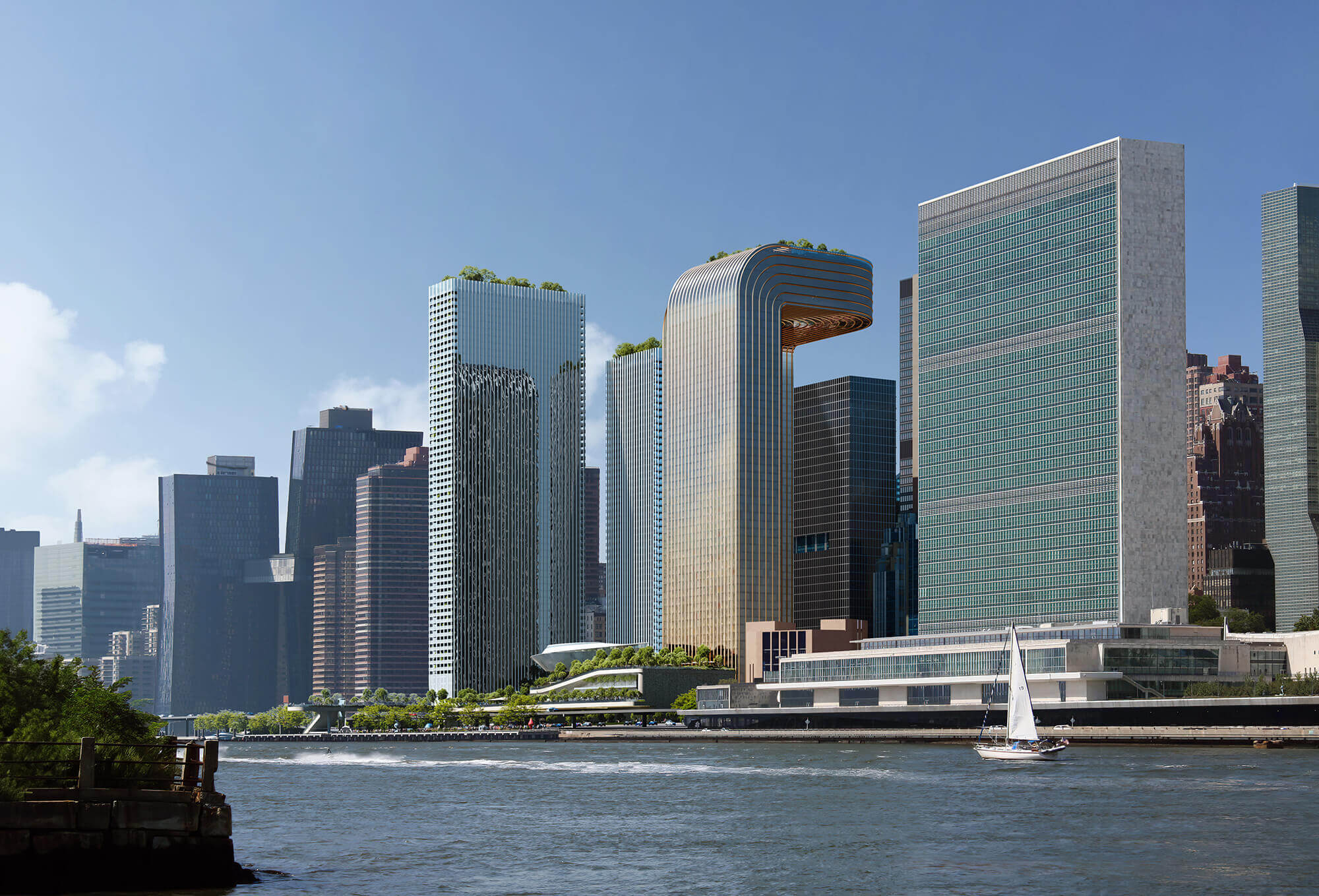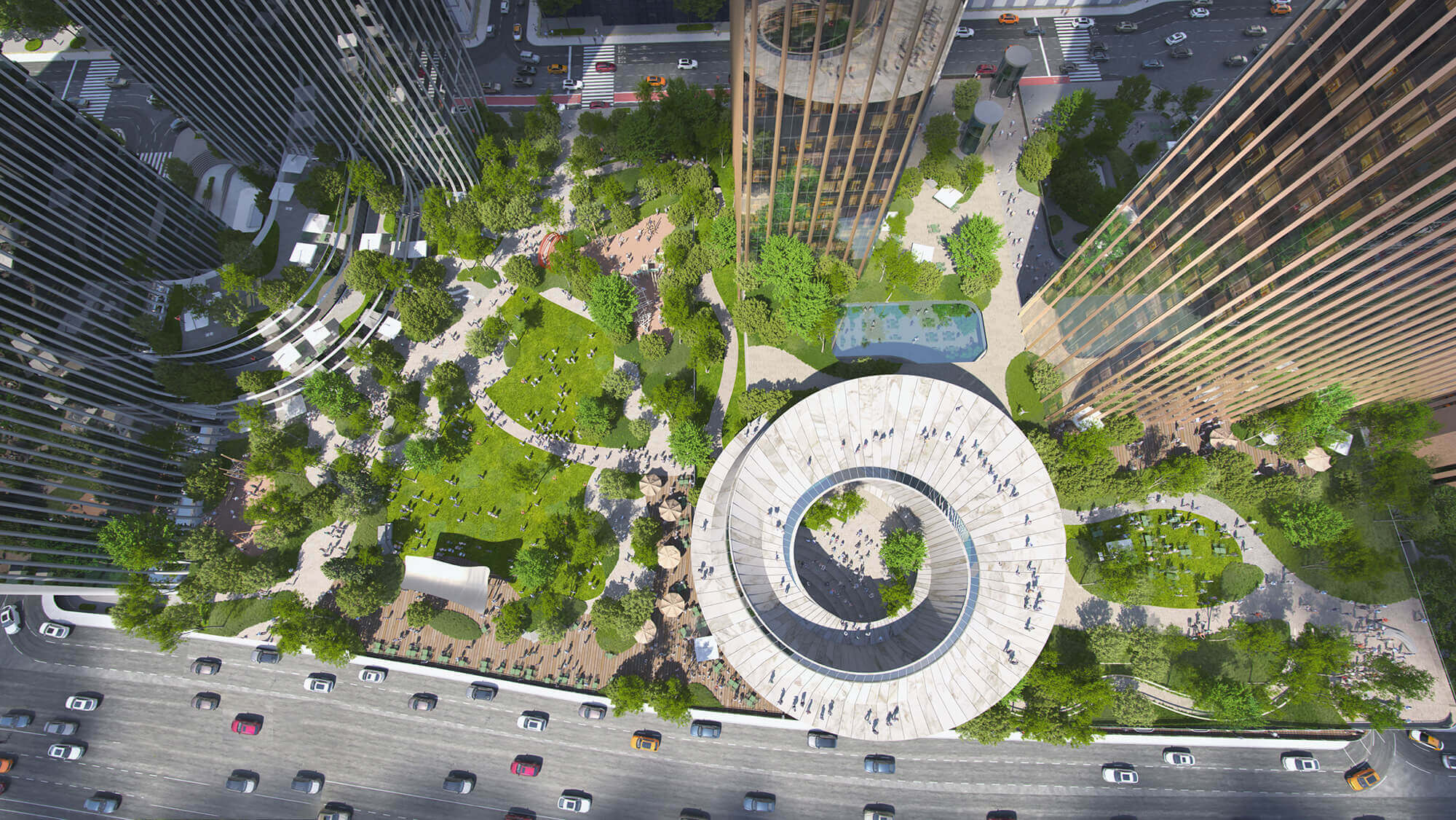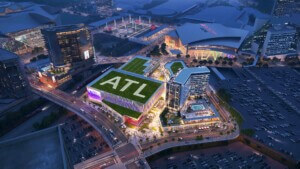This month, Bjarke Ingels Group (BIG), together with Soloviev Group and Mohegan, released renderings of Freedom Plaza, a 4.1 million square foot megaproject next to the United Nations (UN) that will include condos, hotels, a casino, and the world’s first Museum of Freedom and Democracy. Upon completion, the Museum of Freedom and Democracy will feature ephemera that tells the story of democracy’s evolution since ancient Greece, including original pieces of the Berlin Wall that are currently in Soloviev Group chairman Stefan Soloviev’s personal collection. And if Soloviev Group receives its gaming license, a subterranean casino would be tucked underneath the museum. Soloviev Group CEO Michael Hershman told AN that the need for such a museum has only become even more pronounced in recent years due to the “threat to democracy around the world and the growth of authoritarianism.”
In support of AN’s coverage of the project’s announcement, AN’s associate editor Dan Roche interviewed Bjarke Ingels about the museum’s design. Their conversation appears below.

AN: What does it mean to you to design a Museum of Freedom and Democracy? Can you walk me through the design?
Bjarke Ingels (BI): First of all, it’s an incredible honor and privilege. It’s a daunting task to build such a building on such a prominent place in Manhattan, right next to the United Nations.
The Museum of Freedom and Democracy will be designed like an urban agora. It will provide a journey through different cultural, political, and organizational milestones that have led to the formation, and evolution of democracy. Our goal is to allow visitors to immerse themselves in the actual artifacts that are somehow associated with the stepping stones that led to the formation of democracy as it exists today.
AN: What precedents did you use when designing the Museum of Freedom and Democracy? Where did you find inspiration?
BI: We looked at American architecture and experiential design. For the overall building, we tried to give it an almost sort of universal, symbolic form that represents coming together, or assembly. In Scandinavian countries, a lot of the first assembly spaces were where people came together to make decisions for the people and the region. This was before the formation of nation states. The architecture was this sort of circular organization made of stone where everyone would meet in a circle for gathering. We were looking at these spaces.
Then of course we looked at the Agora and amphitheaters in ancient Greece. Our design echoes ancient Greek heritage. So in that sense, the Museum of Freedom and Democracy has two main elements: It’s a circle of stone that creates a museum experience in the form of a loop within, but it also has this kind of iconic backdrop with archetypal elements that symbolize coming together and congregation.
AN: The agora is a very powerful symbol.
BI: Yeah. So for the Museum of Democracy and Freedom, we’re thinking of using Greek marble, a material synonymous with the cradle of democracy.
AN: Is it difficult designing so close to the UN?
BI: To that question, I can say maybe two things. I mean, the United Nations is a restricted place because of the safety and security requirements of the public dignitaries, officials, and politicians who go there. Even though it is a public space with public buildings, it’s very restricted. So what we could do was try to make a genuinely public space that’s an extension of the city out to the water’s edge, which invites in the local community.
Second, if there’s one thing that really characterizes New York, it’s that within the relatively limited acreage of Manhattan’s bedrock, there’s an incredible diversity of activities, functions, and programs that exist. It’s the diversity of activities and places where people live, like event spaces, and museums, plazas, and boardrooms, that makes it vibrant.
We decided to place the gambling underneath the programmatic diversity that the park and Museum of Freedom and Democracy above affords us. It’s the gambling that allows us to actually make such a big public destination on such a valuable site.
AN: So the Museum of Democracy and Freedom will be on top of the casino?
BI: Yes. The spaces for gambling are submerged, so in a very literal way, gambling becomes the site’s economic foundation and also the actual foundation for all these spaces where people will go and live.

AN: Can you talk about how the towers at Freedom Plaza will respond to the UN Headquarters? And how they’ll compliment the East River’s skyline?
BI: First and foremost, the site we’re working with spans the equivalent of three city blocks. So I think in a very similar way to how the UN’s original architects—Le Corbusier, Wallace Harrison, and Oscar Niemeyer—laid out the United Nations Headquarters, we are also creating a series of blocks to build an open space on the East River. You can think of it as a modernist pocket park.
On the East River, the UN created this kind of island of modernism, as an almost international home for the global community on the isle of Manhattan. I think, in some ways, because we actually have three blocks, and because of the elevation change, and of course the presence of FDR Drive below, we actually have a chance to unite those three blocks and create a Freedom Plaza of five acres of public open space with grass and trees. This will connect the city to the water’s edge and create a new public face for the city.
The hotels, condos, and affordable housing are set at two corners: The homes are to the south and the hotels will face the plaza for the community that supports daily life in the neighborhood. The two hotels are designed to create almost like a gateway that face the United Nations. They become an entrance on top of the landscape which leads to Freedom Plaza. Everything will be stone, and landscaping elements will grow out of the bedrock. And then you have the major buildings, the residential and hotel towers, on the corners. We’re thinking of the towers as siblings to the UN that compliment the headquarters in their linear articulation that bends. We plan to use different shades of metal: a cooler one for the residences and a warmer tone for the hotels. They’re similar in nature but have variations.
AN: What challenges have you faced on this project?
BI: In the spirit of the United Nations, both the challenge and joys of this project have been how it will be home to so many different programs and activities. The collaboration we’ve had with Soloviev and Mohegan has been amazing.
As architects and planners, we have been the custodians of this process. I think everyone has really understood the synergistic benefits of allowing each activity to have its ideal placements. In that sense, we’ve been able to create almost five acres of public, open, green space because everybody understood that it’s important for this site to have a public character and generosity that brings the life of the city to the water’s edge.
Everyone at the table has had an understanding and desire to think about the whole and what works best for the city and its communities. Sometimes this means giving up a piece of the pie in order to create a greater whole.











